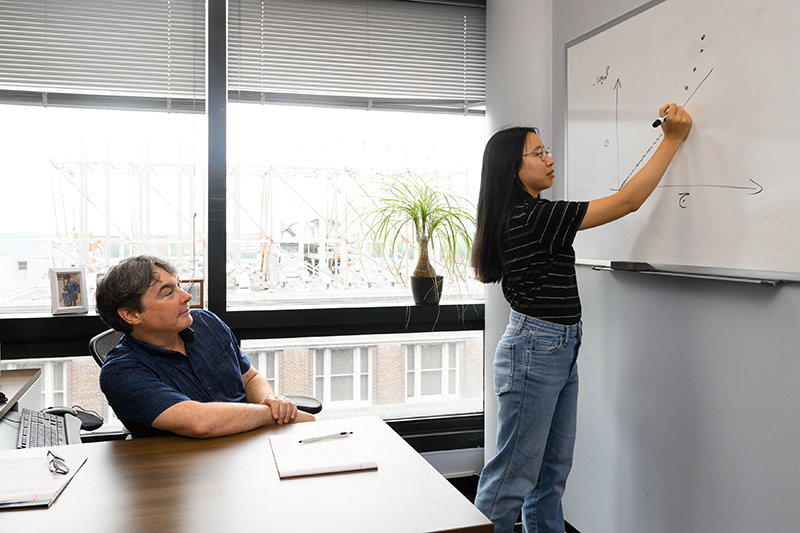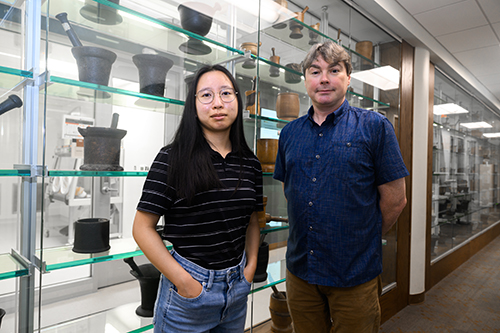VCU, Honors summer program puts two heads together for migraine research
By William Lineberry
Honors College
 Sunwoo Kim spent the summer studying headaches. Not the take-two-aspirin kind of headache, but the type of migraine that leaves thousands of people unable to function in day-to-day activities.
Sunwoo Kim spent the summer studying headaches. Not the take-two-aspirin kind of headache, but the type of migraine that leaves thousands of people unable to function in day-to-day activities.
The goal? Help better understand, through genetic makeup analysis, why migraine medication helps some people and not others.
Kim, a junior in Virginia Commonwealth University’s Honors College, is majoring in biochemistry in the College of Humanities and Sciences. She was paired with Joseph McClay, Ph.D., an associate professor in the School of Pharmacy, for the project through the Honors Summer Undergraduate Research Program, which is a partnership between the Honors College and VCU’s Wright Center for Clinical and Translational Research.
HSURP pairs students from VCU, Old Dominion University, Virginia State University and Virginia Union University with VCU and VCU Health faculty members to spend the summer working together on a project. McClay and Kim studied the genetic makeup of individuals who suffer from refractory migraine – a debilitating form that doesn’t respond to preventative medication – and compare the makeup to those of others whose migraines are more easily treated with medication.
Kim said the project helped her understand the scope of what goes into a research project before publication, and it helped her develop the skill set and confidence for later work. Kim and McClay believe their project laid groundwork for future studies in migraine research, and Kim plans to apply to Ph.D. programs to study pharmacology and chemistry.
To conclude her time working with McClay, Kim presented their findings at the recent HSRUP poster presentation session that included more than 20 other student researchers.
Here, student and mentor share thoughts on what they learned working together.
Sunwoo Kim
What attracted you to this project?
Refractory migraines are considered a very disabling type of migraine. In general, migraine is the leading cause of disability worldwide in women ages 15 to 49. I think it’s important to research this because a lot of the medications that are available to people for migraines are not entirely effective, and having this condition can decrease quality of life.
What did you get out of the experience?
I got a connection with a mentor that I probably would not have been able to connect with otherwise. I learned a lot of skills like coding, research skills and experimental design. In general, I feel like I gained a lot of skills this summer that I can transfer to other projects going forward. I think it is really fortunate I was able to do HSURP because it really offers the opportunity to meet and discuss the project more than I feel like might exist during the semester. It helped ensure that the project progressed at a reasonable pace.
What’s one lesson you learned from Dr. McClay?
I learned more about the behind-the-scenes process of a research project. I was able to see a lot that maybe you do not see from the student side, because we have not been able to see the amount of work that goes into it before the team can get publishable results. I got to see, firsthand, the amount of trial and error that goes into a project like this. I was able to gain an understanding of the months, or sometimes years, it takes before you get to publish your results.

Joseph McClay
Why does this research matter?
A lot of people suffer from migraine but don’t get a lot of relief from the current drugs. Identifying genetic markers associated with refractory migraine could help us figure out why some people don’t respond to treatment. With further research, this could help identify genetic biomarkers that guide patients to specific drugs that are more likely to work, or it could inform future development of new treatments.
How did Sunwoo help advance the project?
Sunwoo really took the lead on the project and ran the data analysis herself, under my supervision. She worked on the All of Us program Researcher Workbench, which is a cloud computing environment linked to a massive NIH-sponsored dataset, to identify patients with migraine, identify those with refractory migraine specifically, merge the patient data with the genomic data and run the analysis.
What’s one lesson you learned from Sunwoo?
Sunwoo came to the HSURP with a clear intention to get the most out of the program that she could. She was very organized and efficient, and completed the full genome scan in just a few short weeks, even though she had fairly limited prior coding experience. Unfortunately, we were unable to find anything concrete in this initial study despite the large size of the sample, but this still tells us something, and we can make further refinements going forward. So, I think I learned from Sunwoo just how much an undergraduate researcher can accomplish in a short time if they really set their mind to it.
This story was originally published on news.vcu.edu. Photos by Jonathan Mehring, Enterprise Marketing and Communications